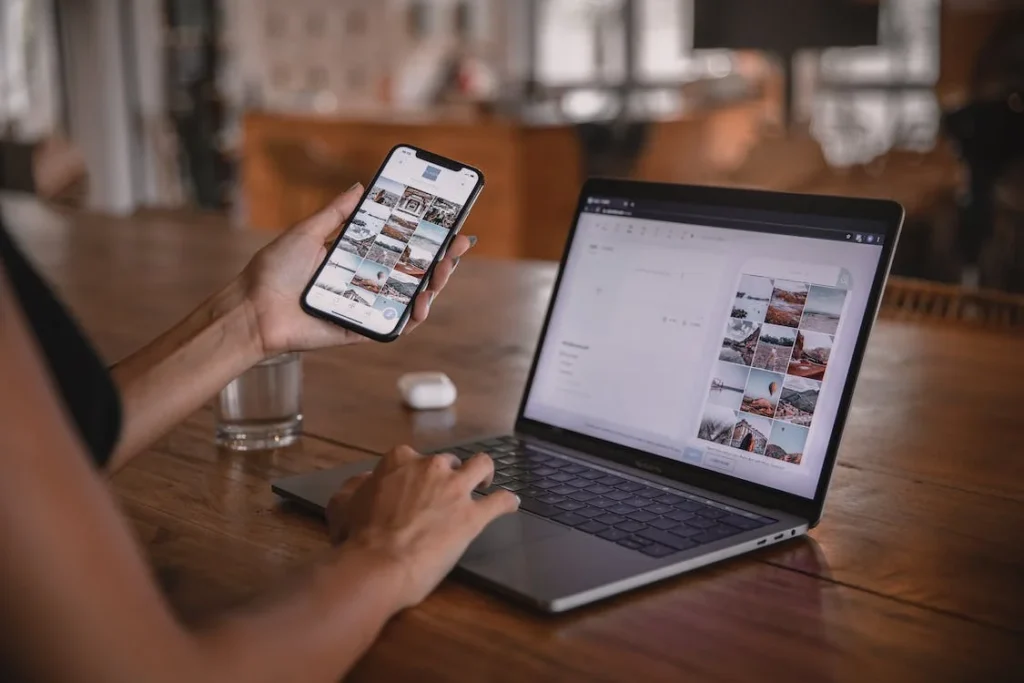This Article has been revised, edited and added to, by Poulomi Chakraborty.
- The Rise of Influencer Marketing in Fashion
- Understanding Influencer Impact
- The New Runway: Social Media Platforms
- Understanding the Evolution and Strategic Importance
- The Symbiotic Relationship Between Brands and Influencers
- Leveraging Data to Identify the Right Influencers
- Tailoring Content to Platform Nuances
- Crafting Compelling Stories and Experiences
- Innovating with Interactive and Immersive Experiences
- Strategic Use of User-Generated Content
- Aligning with Current Trends and Cultural Movements
- Measuring and Adapting for Continuous Improvement
- Identifying the Right Influencers for Your Brand
- Beyond Followers: Relevance and Engagement
- Micro vs. Macro: Size Does Matter
- The Authenticity Factor
- Beyond Followers: Relevance and Engagement
- Deep Diving into Influencer Analytics
- Micro vs. Macro: Size Does Matter
- Strategic Use of Micro and Nano-Influencers
- The Authenticity Factor
- Building Authentic Relationships
- Leveraging Influencer Insights
- Identifying Emerging Influencers
- Navigating Influencer Niches
- Assessing Influencer Brand Fit
- Navigating Contract Negotiations
- Long-Term Collaborations for Greater Impact
- Leveraging Influencer Networks
- Crafting a Winning Influencer Marketing Strategy
- Collaboration Over Dictation
- Storytelling is Key
- Multi-Platform Campaigns
- Building a Collaborative Creative Process
- Storytelling is Key
- Developing Compelling Narratives
- Multi-Platform Campaigns
- Optimizing Content for Different Platforms
- Designing Influencer Campaigns That Resonate
- Defining and Measuring Success Metrics
- Building Relationships and Long-Term Partnerships
- Nurturing Long-Term Relationships
- Leveraging User-Generated Content
- Harnessing the Power of Community
- Crafting the Message: Authenticity and Creativity
- Fostering Authentic Storytelling
- Creativity in Content Presentation
- Pushing Creative Boundaries
- Clear and Compelling Calls-to-Action (CTAs)
- Designing Effective CTAs
- Measuring Success: Analytics and ROI
- Conducting Comprehensive ROI Analysis
- Continuous Improvement Through Feedback and Learning
- Iterative Learning and Optimization
- Designing Influencer Campaigns That Resonate
- Crafting the Message: Authenticity and Creativity
- Measuring Success: Analytics and ROI
- Conclusion
Picture this: You’re scrolling through your social media feed, and there it is—a stunning, eye-catching outfit donned by your favorite style icon. It’s bold, it’s fresh, and it screams ‘you’. Before you know it, you’re clicking through, looking for how you can snag that look. This, folks, is influencer marketing in its most potent form, especially within the fashion industry.
In this comprehensive guide, we’ll explore the ins and outs of influencer marketing tailored for the fashion realm. From picking the right style ambassadors to crafting campaigns that resonate, we’ll walk through how to collaborate with influencers and why it’s not just beneficial but essential for fashion brands in the digital age.
So, buckle up, fashion marketers. Whether you’re a seasoned pro or just dipping your toes into the influencer marketing pool, you’re about to discover how to make a splash in the fashion industry by collaborating with style icons.
The Rise of Influencer Marketing in Fashion

Understanding Influencer Impact
Influencer marketing isn’t just a buzzword; it’s the evolution of personal recommendation in the digital era. In the fashion industry, where visual appeal is king, influencers serve as the modern-day magazine cover stars, with the added bonus of interaction and trust from their followers. Their impact is profound—they shape trends, define what’s “in”, and have the power to shift consumer behavior on a massive scale.
The New Runway: Social Media Platforms
Social media has become the new runway, where influencers showcase the latest fashion trends to their audience. Instagram, with its visual-centric platform, has been at the forefront, but platforms like TikTok, Pinterest, and even LinkedIn play crucial roles in reaching different demographics.
Each platform offers a unique format for content, from short videos to story posts, giving fashion brands a myriad of ways to highlight their products.
Understanding the Evolution and Strategic Importance
Influencer marketing’s meteoric rise in the fashion industry is no accident. It’s rooted in the fundamental shift of consumer behavior towards digital and social media platforms.
Traditional advertising is often seen as impersonal and intrusive, while influencer marketing leverages trusted voices to deliver brand messages in a more relatable and authentic manner. For startup founders, this evolution offers a strategic opportunity to build brand loyalty and drive sales.
The Symbiotic Relationship Between Brands and Influencers
Influencers and fashion brands share a symbiotic relationship where both parties can mutually benefit. For a startup, partnering with influencers can mean instant credibility and exposure to a pre-engaged audience. The key is to understand that this relationship should be nurtured and built on mutual respect and shared goals.
This involves more than just one-off collaborations; it’s about creating long-term partnerships where influencers become brand ambassadors, truly integrating your products into their personal narrative.
Leveraging Data to Identify the Right Influencers
In the digital age, data is a goldmine. Utilize social media analytics tools to identify influencers who align with your brand’s ethos and have a genuine connection with their audience. Look beyond surface-level metrics like follower counts.
Analyze engagement rates, audience demographics, and content performance to ensure the influencers you choose will provide real value and drive meaningful interactions. For instance, if your fashion startup targets eco-conscious consumers, seek influencers who are known for promoting sustainable fashion.
Tailoring Content to Platform Nuances
Each social media platform has its own unique culture and user expectations. For Instagram, high-quality, visually appealing photos and short videos work best. On TikTok, creative, engaging, and sometimes quirky videos can go viral and reach a younger demographic.
Pinterest is ideal for fashion lookbooks and style inspiration, allowing users to pin and save your products to their personal boards. Even LinkedIn can be a powerful tool for showcasing your brand’s journey, values, and behind-the-scenes content, appealing to a more professional audience.
A strategic approach involves crafting platform-specific content that not only fits the medium but also resonates deeply with its users.
Crafting Compelling Stories and Experiences
Storytelling is at the heart of successful influencer marketing. Consumers are drawn to narratives that they can relate to and that evoke emotions. Encourage influencers to create content that tells a story about your brand.
This could be a behind-the-scenes look at the creation of a new fashion line, personal testimonials about why they love your products, or styling tips that incorporate your items into everyday life. By fostering a deeper connection through storytelling, you can turn casual viewers into loyal customers.
Innovating with Interactive and Immersive Experiences
In the highly competitive fashion market, innovation is key. Explore interactive and immersive experiences to captivate your audience. This could include virtual try-ons using augmented reality, where customers can see how your clothing looks on them before making a purchase.
Host live Q&A sessions or fashion shows on social media platforms to engage directly with your audience in real-time. These innovative strategies not only differentiate your brand but also create memorable experiences that can drive higher engagement and conversions.
Strategic Use of User-Generated Content
User-generated content (UGC) is a powerful tool in influencer marketing. It provides authentic, relatable proof of your brand’s value. Encourage influencers to initiate campaigns that invite their followers to share their own photos and stories featuring your products.
This not only amplifies your reach but also builds a community around your brand. For instance, a hashtag campaign where customers post their outfits with your brand’s hashtag can generate a buzz and showcase the versatility and popularity of your fashion line.
Aligning with Current Trends and Cultural Movements
Fashion is inherently tied to cultural trends and movements. Stay ahead of the curve by aligning your influencer marketing campaigns with relevant trends and societal issues.
This could mean supporting diversity and inclusion, promoting body positivity, or advocating for sustainable fashion practices. Authentic alignment with these movements can enhance your brand’s reputation and resonate deeply with consumers who share these values.
Measuring and Adapting for Continuous Improvement
Finally, the success of influencer marketing lies in continuous measurement and adaptation. Utilize comprehensive analytics to track the performance of your campaigns. Monitor engagement rates, conversion metrics, and ROI to understand what works and what doesn’t. Be prepared to pivot your strategy based on these insights, continually refining your approach to maximize impact.
Identifying the Right Influencers for Your Brand

Beyond Followers: Relevance and Engagement
Choosing an influencer solely based on their follower count is a rookie mistake. The key is to partner with influencers who resonate with your brand’s image and values. Their content should speak to your target audience, and their engagement rates (likes, comments, shares) should indicate a genuinely interested following.
Micro vs. Macro: Size Does Matter
Micro-influencers, with their smaller but highly engaged audiences, often yield better ROI for niche fashion brands. Macro-influencers, on the other hand, offer a broader reach and are ideal for creating a buzz on a larger scale. Decide what’s best for your campaign goals and budget.
The Authenticity Factor
Influencers whose style and ethos align with your brand will create more authentic content. Followers are savvy; they can sniff out a disingenuous post from miles away. Authentic partnerships lead to content that feels more like a recommendation from a friend than a blatant ad.
Beyond Followers: Relevance and Engagement
Choosing an influencer solely based on their follower count is a rookie mistake. The key is to partner with influencers who resonate with your brand’s image and values. Their content should speak to your target audience, and their engagement rates (likes, comments, shares) should indicate a genuinely interested following.
Deep Diving into Influencer Analytics
To ensure you choose the right influencer, perform a thorough analysis of their audience demographics, content style, and engagement metrics. Tools like Social Blade, HypeAuditor, and Influencity can provide in-depth insights into an influencer’s follower growth, audience location, age, gender, and interests. Analyzing these data points helps you determine if the influencer’s audience aligns with your target market, ensuring higher relevance and engagement for your campaigns.
Micro vs. Macro: Size Does Matter
Micro-influencers, with their smaller but highly engaged audiences, often yield better ROI for niche fashion brands. Macro-influencers, on the other hand, offer a broader reach and are ideal for creating a buzz on a larger scale. Decide what’s best for your campaign goals and budget.
Strategic Use of Micro and Nano-Influencers
While macro-influencers can amplify your reach, micro and nano-influencers can drive higher engagement and authenticity. These influencers often have a more personal connection with their followers, leading to higher trust and credibility.
For startups, collaborating with multiple micro-influencers can create a network effect, where numerous smaller voices collectively amplify your brand message. This approach is cost-effective and can result in higher conversions due to the perceived authenticity of these influencers.
The Authenticity Factor
Influencers whose style and ethos align with your brand will create more authentic content. Followers are savvy; they can sniff out a disingenuous post from miles away. Authentic partnerships lead to content that feels more like a recommendation from a friend than a blatant ad.
Building Authentic Relationships
Authenticity in influencer marketing stems from genuine relationships between the brand and the influencer. Engage with potential influencers through their content by liking, commenting, and sharing their posts before reaching out for collaboration.
This not only shows your interest in their work but also helps you understand their style and how they interact with their audience. When approaching influencers, personalize your outreach by referencing specific content of theirs that you admire and explaining why you believe your brand aligns with their personal brand.
Authentic relationships lead to more enthusiastic and genuine collaborations, resulting in more impactful content.
Leveraging Influencer Insights
Influencers have a unique understanding of their audience’s preferences and behaviors. Collaborate closely with them to gain insights into what content resonates most with their followers.
This can inform your broader marketing strategy and help you create content that is more likely to engage your target audience. By leveraging influencer insights, you can fine-tune your messaging, product offerings, and campaign tactics to better align with consumer trends and preferences.
Identifying Emerging Influencers
Stay ahead of trends by identifying and partnering with emerging influencers before they hit mainstream popularity. These influencers are often more approachable and open to collaboration with new brands.
Utilize social listening tools to monitor trending topics and hashtags within your niche, and identify influencers who are gaining traction. Engaging with emerging influencers early can secure long-term partnerships and position your brand as a trendsetter.
Navigating Influencer Niches
Fashion is a broad industry with numerous niches, from streetwear and haute couture to sustainable fashion and athleisure. Identify influencers who specialize in the specific niche that aligns with your brand. These niche influencers often have highly targeted and engaged audiences.
Collaborating with them allows you to tap into a concentrated group of potential customers who are more likely to be interested in your products. This strategic focus can enhance the relevance and impact of your influencer marketing efforts.
Assessing Influencer Brand Fit
A critical aspect of selecting the right influencer is ensuring a strong brand fit. Review the influencer’s past collaborations, content style, and overall persona to determine if they genuinely align with your brand’s image and values.
An influencer who naturally integrates your products into their lifestyle and content will create more believable and impactful promotions. Consider conducting a small test campaign with potential influencers to assess their ability to authentically represent your brand before committing to larger partnerships.
Navigating Contract Negotiations
Once you’ve identified the right influencers, clear and fair contract negotiations are essential. Outline the scope of work, content expectations, posting schedules, and compensation terms in detail.
Include clauses for content ownership, usage rights, and performance metrics to ensure both parties are aligned. Transparent communication and well-defined agreements can prevent misunderstandings and foster positive long-term relationships with influencers.
Long-Term Collaborations for Greater Impact
Building long-term partnerships with influencers can yield greater benefits than one-off campaigns. When influencers consistently promote your brand, it builds trust and credibility with their audience.
Long-term collaborations allow influencers to create more in-depth content and share their genuine experiences with your products. This sustained exposure helps in embedding your brand in the minds of their followers, leading to higher brand loyalty and increased conversion rates.
Leveraging Influencer Networks
Influencers often have connections with other influencers in their niche. Leveraging these networks can amplify your reach and impact. Encourage your influencer partners to recommend your brand to their peers or collaborate on joint campaigns. This strategy can create a ripple effect, where multiple influencers endorse your brand, increasing visibility and credibility.

Crafting a Winning Influencer Marketing Strategy
Collaboration Over Dictation
A common mistake is treating influencers like ad spaces. Instead, view them as creative partners. They know their audience best, so give them the creative freedom to showcase your products in a way that feels natural to their personal brand.
Storytelling is Key
Fashion is more than clothing—it’s a lifestyle, an attitude, a form of self-expression. Encourage influencers to tell a story with your fashion pieces. How does wearing your brand make them feel? What occasions are your outfits perfect for? Stories sell, not products.
Multi-Platform Campaigns
Don’t put all your eggs in one basket. A campaign that spans across multiple platforms increases your chances of reaching your target audience, no matter where they hang out. It also helps in repurposing content to fit different platforms, maximizing your campaign’s reach.
Building a Collaborative Creative Process
Involving influencers in the creative process from the beginning can lead to more authentic and impactful content. Start by sharing your brand’s vision, goals, and key messages, and then invite the influencer to contribute their ideas.
This collaborative approach ensures that the content produced is a true reflection of both your brand and the influencer’s style. Hold brainstorming sessions to explore creative concepts and let the influencer’s unique voice and perspective shine through.
This co-creation not only results in more engaging content but also strengthens the relationship between your brand and the influencer.
Storytelling is Key
Fashion is more than clothing—it’s a lifestyle, an attitude, a form of self-expression. Encourage influencers to tell a story with your fashion pieces. How does wearing your brand make them feel? What occasions are your outfits perfect for? Stories sell, not products.
Developing Compelling Narratives
The power of storytelling in influencer marketing cannot be overstated. Work with influencers to develop narratives that connect emotionally with their audience. For instance, create a campaign around the journey of your fashion pieces—from design inspiration to production to the final product.
Highlight behind-the-scenes moments, designer stories, and the craftsmanship involved. Personal stories, such as how an outfit made the influencer feel confident at a significant event, can also resonate deeply. These narratives help create a stronger emotional connection with potential customers, making your brand more memorable and appealing.
Multi-Platform Campaigns
Don’t put all your eggs in one basket. A campaign that spans across multiple platforms increases your chances of reaching your target audience, no matter where they hang out. It also helps in repurposing content to fit different platforms, maximizing your campaign’s reach.
Optimizing Content for Different Platforms

Each social media platform has its unique strengths and user behaviors. Tailor your content to leverage these differences. For Instagram, focus on high-quality images and engaging stories. TikTok requires short, dynamic videos that capture attention quickly.
Pinterest is ideal for inspirational and shoppable content, while LinkedIn can be used for professional fashion insights and industry trends. By optimizing your content for each platform, you ensure that your campaign resonates with users across different social media landscapes, enhancing visibility and engagement.
Designing Influencer Campaigns That Resonate
To launch a successful influencer campaign, you must first pinpoint what success looks like. Is it increased brand awareness, more followers, or direct sales? Once you have this, communicate your goals with your chosen influencers clearly, along with any expectations regarding content, posting schedules, and messaging.
Defining and Measuring Success Metrics
Establishing clear, measurable objectives for your influencer campaigns is crucial. Determine key performance indicators (KPIs) that align with your goals, such as engagement rates, website traffic, conversion rates, and sales.
Utilize tools like Google Analytics, social media insights, and custom tracking links to monitor these metrics. Regularly review the data and adjust your strategy based on performance. This data-driven approach ensures that you can quantify the impact of your influencer marketing efforts and make informed decisions for future campaigns.
Building Relationships and Long-Term Partnerships
The most impactful influencer relationships are those built over time. Consider long-term collaborations where influencers become brand ambassadors. This not only shows that they genuinely stand behind your brand but also gives their audience time to develop trust and interest in your offerings.
Nurturing Long-Term Relationships
Fostering long-term partnerships with influencers can yield significant benefits. Regularly engage with your influencers beyond campaign periods by sending them new products, inviting them to exclusive events, or involving them in product development.
This continuous engagement helps build a stronger bond, making influencers more invested in your brand. Additionally, long-term partnerships allow for more strategic planning and consistent messaging, reinforcing your brand’s presence and credibility over time.
Leveraging User-Generated Content
Encourage influencers to create content that prompts their followers to participate—like styling challenges or contests. User-generated content can amplify your campaign’s reach and create a sense of community around your brand.
Harnessing the Power of Community
Creating opportunities for user-generated content (UGC) can significantly enhance your campaign’s reach and authenticity. Design interactive campaigns that encourage followers to share their own experiences with your brand, such as photo contests, hashtag challenges, or review videos.
Feature this UGC on your brand’s social media channels and website, showcasing real customers enjoying your products. This not only builds a sense of community but also provides social proof, which can influence potential customers’ purchasing decisions.
Crafting the Message: Authenticity and Creativity
For a message to resonate, there must be a natural synergy between the influencer’s style and your brand’s aesthetic. Influencers should integrate your pieces into their content in a way that feels seamless and genuine.
Fostering Authentic Storytelling
Authenticity is key in influencer marketing. Encourage influencers to share personal stories and experiences related to your brand. Authentic storytelling can highlight the emotional and functional benefits of your products, making them more relatable and desirable.
Work with influencers to create content that feels organic and spontaneous, rather than overly scripted. This approach can build trust with the audience and foster a deeper connection with your brand.
Creativity in Content Presentation
Fashion is about visual impact. Brainstorm with influencers to create unique, attention-grabbing content formats, whether it’s a ‘day in the life’ wearing your brand, a fashion haul, a transformation video, or a lookbook.
Pushing Creative Boundaries
Encourage influencers to experiment with different content formats and styles to capture attention and engage their audience. Interactive content, such as polls, Q&A sessions, and live streams, can enhance engagement and provide real-time interaction with followers.
Collaborate on innovative concepts like virtual fashion shows, augmented reality try-ons, or behind-the-scenes content. By pushing creative boundaries, you can create memorable and impactful campaigns that stand out in the crowded fashion market.
Clear and Compelling Calls-to-Action (CTAs)
A beautiful post is good, but it needs to be coupled with a clear CTA. What do you want followers to do after viewing the content? Visit your website, follow your brand, make a purchase? Make sure the CTA is straightforward and easy to follow.
Designing Effective CTAs
Effective CTAs are crucial for driving desired actions from your audience. Ensure that CTAs are prominently placed within the content and clearly communicate the next steps. Utilize action-oriented language and provide incentives, such as discounts, exclusive offers, or free trials, to encourage immediate action.
Test different CTA variations to determine which ones resonate best with your audience and optimize accordingly. A well-crafted CTA can significantly boost conversion rates and maximize the impact of your influencer marketing efforts.
Measuring Success: Analytics and ROI
Use trackable links, promo codes, and platform analytics to monitor how each influencer’s content is performing. Keep an eye on metrics like engagement rates, traffic generated, and conversion rates to measure the success of the campaign.
Conducting Comprehensive ROI Analysis
Evaluating ROI goes beyond counting likes and comments. Consider sales figures, customer acquisition costs, and long-term value generated from the campaign. This will inform your future strategy and help in selecting the right influencers.
Continuous Improvement Through Feedback and Learning
Post-campaign, gather feedback from both the influencers and their audience. What worked? What didn’t? This will provide valuable insights for future campaigns.
Iterative Learning and Optimization
Post-campaign analysis is crucial for continuous improvement. Conduct debrief sessions with influencers to gather their perspectives on what worked well and what could be improved. Analyze audience feedback and engagement data to identify patterns and preferences.
Use these insights to refine your strategy, optimize future campaigns, and enhance collaboration processes. Iterative learning and optimization can drive long-term success and help your brand stay ahead in the dynamic fashion industry.
Designing Influencer Campaigns That Resonate

Setting Clear Goals and Expectations
To launch a successful influencer campaign, you must first pinpoint what success looks like. Is it increased brand awareness, more followers, or direct sales? Once you have this, communicate your goals with your chosen influencers clearly, along with any expectations regarding content, posting schedules, and messaging.
Building Relationships and Long-Term Partnerships
The most impactful influencer relationships are those built over time. Consider long-term collaborations where influencers become brand ambassadors. This not only shows that they genuinely stand behind your brand but also gives their audience time to develop trust and interest in your offerings.
Leveraging User-Generated Content
Encourage influencers to create content that prompts their followers to participate—like styling challenges or contests. User-generated content can amplify your campaign’s reach and create a sense of community around your brand.
Crafting the Message: Authenticity and Creativity
Finding the Brand-Influencer Synergy
For a message to resonate, there must be a natural synergy between the influencer’s style and your brand’s aesthetic. Influencers should integrate your pieces into their content in a way that feels seamless and genuine.
Creativity in Content Presentation
Fashion is about visual impact. Brainstorm with influencers to create unique, attention-grabbing content formats, whether it’s a ‘day in the life’ wearing your brand, a fashion haul, a transformation video, or a lookbook.
Clear and Compelling Calls-to-Action (CTAs)
A beautiful post is good, but it needs to be coupled with a clear CTA. What do you want followers to do after viewing the content? Visit your website, follow your brand, make a purchase? Make sure the CTA is straightforward and easy to follow.
Measuring Success: Analytics and ROI

Tracking Performance Metrics
Use trackable links, promo codes, and platform analytics to monitor how each influencer’s content is performing. Keep an eye on metrics like engagement rates, traffic generated, and conversion rates to measure the success of the campaign.
ROI Analysis
Evaluating ROI goes beyond counting likes and comments. Consider sales figures, customer acquisition costs, and long-term value generated from the campaign. This will inform your future strategy and help in selecting the right influencers.
Feedback and Learning
Post-campaign, gather feedback from both the influencers and their audience. What worked? What didn’t? This will provide valuable insights for future campaigns.
Conclusion
Influencer marketing in the fashion industry is much more than a passing trend—it’s a dynamic and vital part of brand strategy that requires thought, creativity, and genuine relationships. By collaborating with style icons, you can bring your brand to life in the eyes of consumers and weave your fashion stories into the fabric of their daily lives. It’s about inspiring, engaging, and ultimately driving action that benefits both the brand and the influencer’s audience.
As we’ve seen, the key to success lies in choosing the right influencers, creating content that resonates, and maintaining strong, mutually beneficial relationships. With careful planning, creativity, and the courage to embrace new trends and platforms, your influencer campaigns can achieve measurable success and leave a lasting impact on both your brand and your consumers.
Fashion marketing is an ever-evolving landscape, but one thing remains constant: the power of connection. Influencer marketing harnesses that power, turning every post, every story, and every collaboration into an opportunity to connect with people in a way that’s real, relatable, and deeply influential.
Read Next:
- The Importance of A/B Testing in Influencer Marketing: Optimizing for Maximum Impact
- Influencer Marketing for the Home and Living Sector: Collaborating with Lifestyle Influencers
- Influencer Marketing for the Finance Sector: Collaborating with Financial Experts
- The Power of Exclusive Deals and Discounts in Influencer Marketing
- Influencer Marketing for the Entertainment Industry: Collaborating with Celebrities and Artists






















Comments are closed.